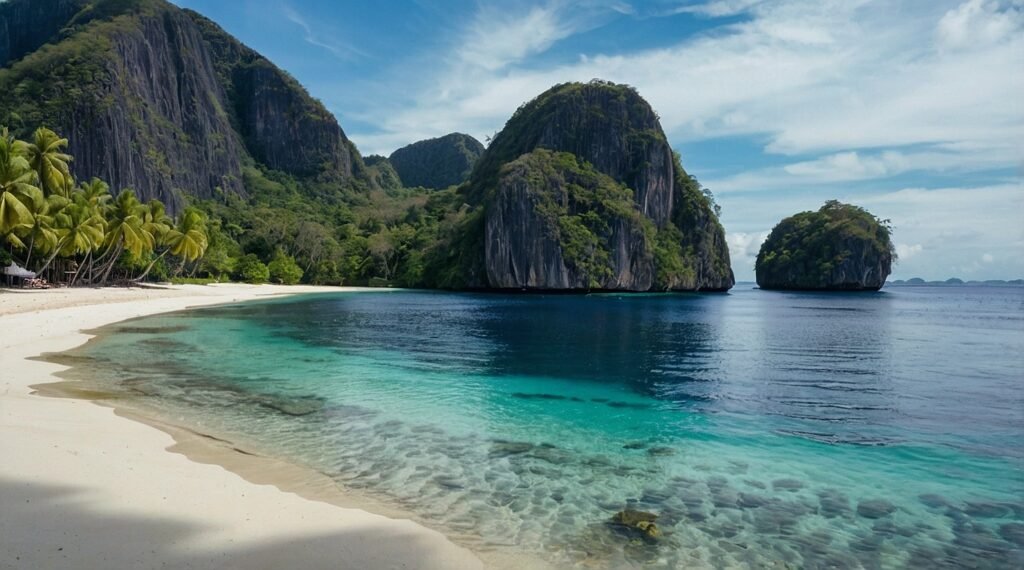The Philippine archipelago is renowned for its stunning coastlines and crystal-clear waters, but among its many gems, Palawan stands out as a true paradise for beach enthusiasts and nature lovers alike. This long, narrow island province, often referred to as the “Last Frontier of the Philippines,” has consistently garnered international recognition for its pristine beaches and unspoiled natural beauty. In this comprehensive exploration, we will delve into the award-winning shores of Palawan, examining their unique characteristics, ecological significance, and the factors that contribute to their world-class status. From the powdery white sands to the vibrant marine ecosystems that thrive beneath the surface, Palawan’s beaches offer an unparalleled experience that continues to captivate travelers from around the globe. As we embark on this journey through Palawan’s coastal wonders, we will uncover the secrets behind their enduring allure and the efforts being made to preserve these natural treasures for generations to come.
The Geography of Palawan
Palawan’s unique geographical features play a crucial role in shaping its magnificent coastline. Situated between the South China Sea and the Sulu Sea, this elongated island province stretches over 450 kilometers from north to south, boasting an impressive 2,000 kilometers of irregular coastline. This extensive shoreline is characterized by a diverse array of geological formations, including limestone cliffs, hidden coves, and expansive sandy beaches. The province encompasses not only the main island of Palawan but also nearly 1,780 surrounding islands and islets, each contributing to the region’s rich coastal tapestry. The topography of Palawan is equally varied, with rugged mountain ranges running the length of the island, creating a dramatic backdrop for its coastal areas. This mountainous interior, combined with the surrounding seas, influences local weather patterns and contributes to the unique microclimates found along different stretches of the coast.
Climate and Weather Patterns
Palawan’s tropical climate is characterized by two distinct seasons: the dry season from November to May and the wet season from June to October. The average annual temperature ranges from 26°C to 28°C (79°F to 82°F), with relatively high humidity levels throughout the year. These climatic conditions, coupled with the warm waters of the surrounding seas, create an ideal environment for both beachgoers and marine life. The region’s weather patterns also play a significant role in shaping its coastline, with monsoon winds and occasional tropical storms contributing to the natural processes of erosion and sediment deposition that maintain the beaches’ pristine condition.
Biodiversity Hotspot
Palawan is recognized as a biodiversity hotspot, home to a vast array of plant and animal species, many of which are endemic to the region. This extraordinary biodiversity extends to its marine ecosystems, with coral reefs, seagrass beds, and mangrove forests supporting a rich variety of aquatic life. The province’s strategic location at the biogeographic boundary between the Sunda Shelf and the Philippine archipelago contributes to its unique ecological composition. This convergence of diverse habitats and species makes Palawan’s coastal areas not only visually stunning but also ecologically significant on a global scale.
Award-Winning Beaches of Palawan
Palawan’s beaches have consistently received accolades from international travel publications and organizations, cementing their status as some of the world’s finest coastal destinations. These awards recognize not only the aesthetic beauty of the beaches but also their environmental quality, sustainability practices, and overall visitor experience. Let’s examine some of the most notable award-winning shores in Palawan and the factors that contribute to their prestigious status.
El Nido’s Hidden Beach
Hidden Beach in El Nido has garnered significant attention, being named the best beach in Asia by Condé Nast Traveler in 2020. This secluded cove, accessible only by boat or a challenging trek, is renowned for its pristine white sand, crystal-clear waters, and dramatic limestone cliffs. The beach’s relative inaccessibility has helped preserve its natural beauty, making it a prime example of Palawan’s unspoiled coastal landscapes. Visitors to Hidden Beach often describe the experience as otherworldly, with the towering karst formations creating a sense of seclusion and intimacy with nature.
Nacpan Beach
Consistently ranked among the top beaches in the Philippines, Nacpan Beach in El Nido is a four-kilometer stretch of golden sand backed by coconut palms. Its expansive shoreline and relatively undeveloped surroundings offer visitors a more tranquil alternative to some of the busier beaches in the region. Nacpan Beach has been praised for its cleanliness, safety, and the quality of its sand and water. The beach’s gentle slope and calm waters make it ideal for swimming, while its westward orientation provides spectacular sunset views, adding to its appeal among travelers and photographers alike.
Honda Bay’s Starfish Island
While not a traditional beach in the strictest sense, Starfish Island in Honda Bay has earned recognition for its unique marine ecosystem and pristine sandbar. This small island, named for the abundance of starfish found in its shallow waters, offers visitors the opportunity to wade through crystal-clear seas and observe marine life up close. The island’s commitment to conservation, including strict guidelines for interacting with marine creatures, has contributed to its positive reputation among eco-conscious travelers and marine enthusiasts.
Table: Notable Awards and Recognitions for Palawan’s Beaches
| Beach/Location | Award/Recognition | Year | Awarding Body |
|---|---|---|---|
| Hidden Beach, El Nido | Best Beach in Asia | 2020 | Condé Nast Traveler |
| Nacpan Beach, El Nido | Top 10 Beaches in Asia | 2018 | TripAdvisor Travelers’ Choice Awards |
| Palawan Island | Best Island in the World | 2020 | Travel + Leisure |
| El Nido | Top 20 Most Beautiful Beaches in the World | 2017 | Condé Nast Traveler |
| Palawan | World’s Best Island | 2013, 2016, 2017 | Travel + Leisure |
Factors Contributing to Beach Quality
The exceptional quality of Palawan’s beaches can be attributed to a combination of natural factors and human efforts to preserve these coastal environments. Understanding these elements provides insight into why Palawan’s shores consistently rank among the world’s best and what measures are necessary to maintain their pristine condition.
Water Clarity and Purity
One of the most striking features of Palawan’s beaches is the exceptional clarity of their waters. This clarity is the result of several factors, including:
- Limited runoff due to the island’s topography and vegetation cover
- Absence of major industrial activities that could contribute to water pollution
- Natural filtration processes provided by coral reefs and seagrass beds
- Strong currents that help disperse sediments and maintain water quality
The purity of the water not only enhances the aesthetic appeal of the beaches but also supports thriving marine ecosystems, making Palawan a premier destination for snorkeling and diving enthusiasts.
Sand Quality and Composition
The composition and texture of beach sand play a crucial role in the overall quality and appeal of a shoreline. Palawan’s beaches are known for their fine, powdery sand, which is primarily composed of:
- Pulverized coral and shells
- Quartz and silica particles
- Volcanic minerals from ancient geological processes
This unique composition results in sand that is not only visually appealing but also comfortable to walk on and resistant to heat retention, enhancing the beach experience for visitors.
Coastal Vegetation and Landscapes
The natural beauty of Palawan’s beaches is often enhanced by the surrounding coastal vegetation and dramatic landscapes. Many of the province’s shores are fringed by:
- Coconut palms and other native trees
- Mangrove forests that protect the coastline from erosion
- Limestone cliffs and karst formations that create secluded coves and lagoons
This diverse coastal topography not only provides a stunning backdrop for beachgoers but also plays a critical role in maintaining the ecological balance of the shoreline.
Environmental Conservation Efforts
The preservation of Palawan’s pristine beaches is not solely the result of natural processes but also reflects concerted efforts by local communities, government agencies, and environmental organizations. These initiatives aim to protect the delicate coastal ecosystems while promoting sustainable tourism practices.
Marine Protected Areas
Palawan has established numerous Marine Protected Areas (MPAs) to safeguard its coastal and marine resources. These designated zones serve multiple purposes:
- Protecting critical habitats for marine species
- Allowing fish populations to recover from overfishing
- Preserving coral reefs and other sensitive ecosystems
- Providing opportunities for scientific research and education
The implementation of MPAs has contributed significantly to the health and resilience of Palawan’s coastal environments, ensuring that its beaches remain pristine for future generations.
Sustainable Tourism Practices
Recognizing the potential impacts of increasing tourism on its natural resources, Palawan has implemented various sustainable tourism practices, including:
- Limiting visitor numbers to certain beaches and islands
- Promoting eco-friendly accommodations and tour operators
- Implementing strict waste management policies
- Educating visitors about responsible tourism practices
These measures help balance the economic benefits of tourism with the need to protect Palawan’s fragile ecosystems.
Community-Based Conservation Programs
Local communities play a crucial role in the conservation of Palawan’s beaches. Many towns and villages have implemented community-based programs that focus on:
- Regular beach clean-ups and monitoring
- Mangrove reforestation projects
- Alternative livelihood programs to reduce pressure on marine resources
- Environmental education initiatives for residents and visitors
These grassroots efforts have fostered a sense of stewardship among local populations, contributing to the long-term sustainability of Palawan’s coastal areas.
Challenges and Future Outlook
Despite the current pristine state of Palawan’s beaches, the region faces several challenges that could impact their future quality and appeal. Addressing these issues is crucial for maintaining the province’s status as a world-class beach destination.
Climate Change Impacts
Climate change poses a significant threat to Palawan’s coastal ecosystems, with potential impacts including:
- Rising sea levels that could erode beaches and inundate low-lying areas
- Increased water temperatures leading to coral bleaching and ecosystem disruption
- More frequent and intense tropical storms causing coastal damage
- Changes in ocean chemistry affecting marine life and coral growth
Efforts to mitigate and adapt to these climate-related challenges will be essential for preserving Palawan’s beaches in the coming decades.
Balancing Development and Conservation
As Palawan’s popularity as a tourist destination continues to grow, balancing economic development with environmental conservation becomes increasingly challenging. Key issues include:
- Pressure to develop previously untouched coastal areas
- Increasing demand for infrastructure and accommodations
- Potential overexploitation of natural resources
- Managing waste and pollution from growing populations and visitor numbers
Sustainable development strategies that prioritize environmental protection while supporting local economies will be crucial for maintaining the quality of Palawan’s beaches.
Emerging Environmental Threats
In addition to climate change and development pressures, Palawan’s beaches face other environmental challenges, such as:
- Marine plastic pollution from local and global sources
- Invasive species that could disrupt native ecosystems
- Potential impacts from offshore resource extraction activities
- Overfishing and illegal fishing practices affecting marine biodiversity
Addressing these threats will require ongoing monitoring, research, and collaborative efforts among various stakeholders.
Conclusion
Palawan’s pristine beaches stand as a testament to the extraordinary natural beauty of the Philippines and the effectiveness of concerted conservation efforts. From the powdery white sands of El Nido to the unique marine ecosystems of Honda Bay, these award-winning shores continue to captivate visitors from around the world. The factors contributing to their exceptional quality – crystal-clear waters, fine sand composition, and stunning coastal landscapes – are the result of both natural processes and human stewardship.
As we look to the future, the preservation of Palawan’s beaches faces significant challenges, including climate change impacts, development pressures, and emerging environmental threats. However, the ongoing commitment to sustainable tourism practices, community-based conservation programs, and environmental protection measures provides hope for the long-term sustainability of these coastal treasures.
Palawan’s beaches are not merely picturesque destinations but vital ecosystems that support biodiversity, local livelihoods, and cultural heritage. Their continued recognition as some of the world’s finest shores underscores the importance of balancing tourism development with rigorous environmental conservation. As global awareness of the value of pristine natural environments grows, Palawan’s beaches serve as an inspiring example of how exceptional coastal areas can be preserved and appreciated for generations to come.
By fostering a deep appreciation for these natural wonders and supporting sustainable practices, visitors and residents alike can contribute to ensuring that Palawan’s pristine beaches remain a source of beauty, biodiversity, and inspiration far into the future.
Disclaimer: This article is based on research and publicly available information as of April 2024. While efforts have been made to ensure accuracy, environmental conditions and conservation statuses may change over time. Readers are encouraged to consult current local sources and environmental agencies for the most up-to-date information on Palawan’s beaches. If you notice any inaccuracies in this report, please contact us promptly so we can make the necessary corrections.
. If ou notice any inaccuracies in this post, please report them so we can promptly make corrections.




